There’s a trend that has recently divided the internet, and it’s called “quiet quitting.”
Organizations, employees, researchers, and just about everyone in between have jumped on the bandwagon to contribute their thoughts on this social movement, which is centered around rejecting hustle culture in favor of work-life balance.
Yet, despite what side of the fence you sit on, there’s one truth we cannot deny: quiet quitting is causing a significant shift in the way organizations handle disengaged employees in an already tumultuous market where candidates are few and far between.
In this article, we’ll explore the roots of quiet quitting, how it currently looks in the US market, and what organizations can do to help create workplaces conducive to productivity and engagement.
What is quiet quitting — and where did it come from?
The term “quiet quitting” recently rose to fame when social media content creator, Zaiad Khan, posted a video on TikTok explaining the concept: the rejection of hustle culture and reclamation of work-life balance. Since its debut on TikTok on July 26th, Khan’s video has racked up over 3.5 million views and stirred much debate.
Despite its name, quiet quitting has little to do with leaving your job and seeking new employment. Instead, the term refers to completing your contractual agreement and responsibilities while avoiding additional effort to go the extra mile. This might include clocking off on the dot, not raising your hand to take on additional responsibilities, and regularly taking leave.
As Khan explains, “you aren’t outright quitting your job, but are quitting the idea of going above and beyond. You’re still performing your duties, but you’re no longer subscribing to the hustle culture mentality that work has to be your life.”
This notion has divided the internet, splitting people into two opposing camps.
On the one hand, some employees agree that their work responsibilities shouldn’t extend beyond those outlined in their job description, particularly when not fairly compensated for the additional duties. Those in favor of quiet quitting argue that setting work boundaries — finishing at a reasonable hour, not checking emails outside of work hours, taking owed leave, etc. — is essential to maintaining a healthy life balance.
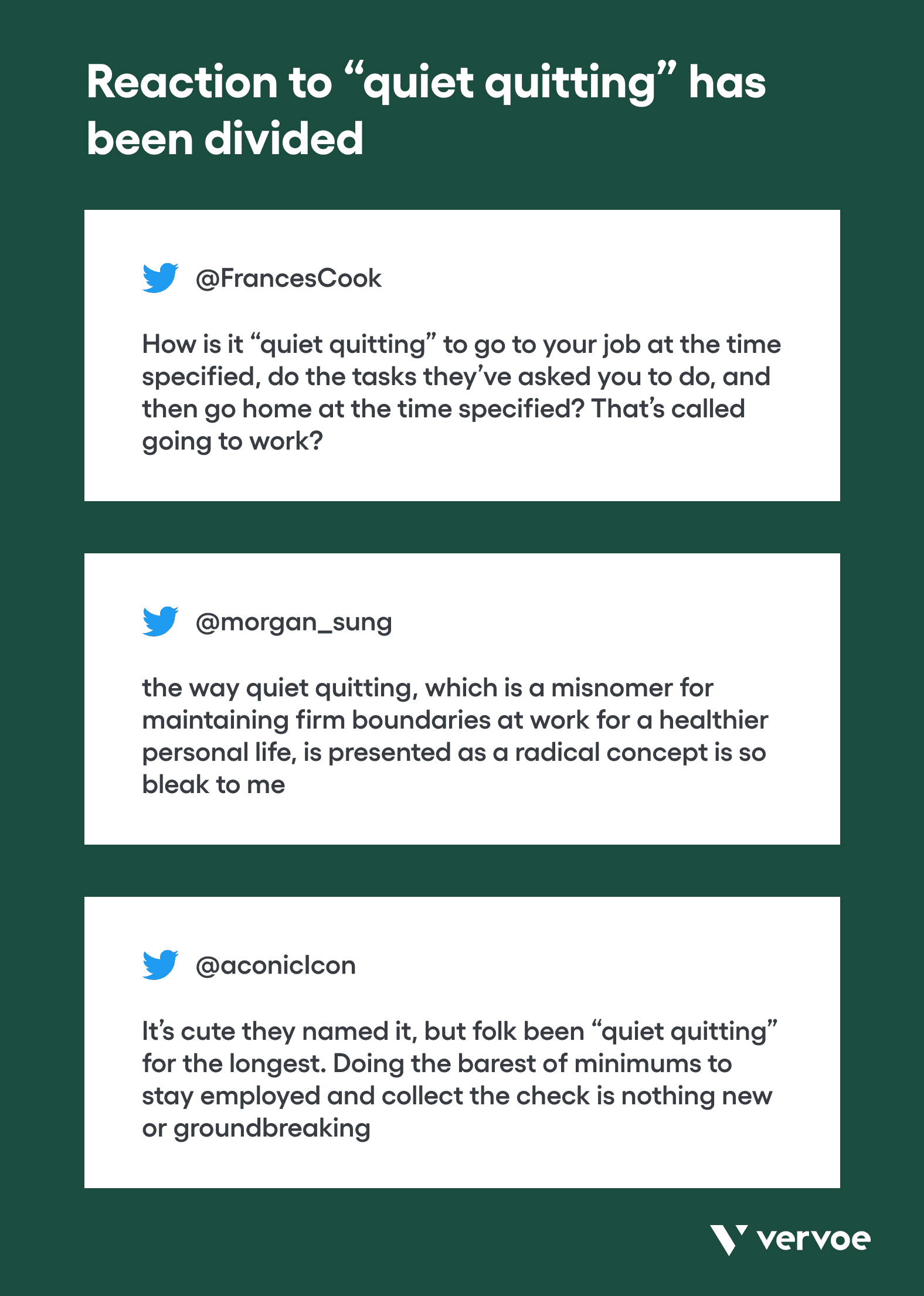
Yet, those on the opposing side believe it’s an unspoken agreement that employees should be willing to collaborate and put their hands up for more projects in the name of career development and ambition. This side of the fence believes that simply attending work to do the bare minimum while feeling completely disengaged and disinterested in development is doing employers and teams a disservice.
Quiet quitting is growing in the US
According to Gallup’s State of the Global Workplace: 2022 Report, quiet quitting is growing in the US:
- “Quiet quitters” currently comprise roughly 50% of the US workforce, potentially more.
- Employee engagement in the US has dropped again in the second quarter of 2022. The ratio of engaged to actively disengaged workers currently sits at 1.8 to 1 — the lowest in a decade.
- Quiet quitting appears to be impacting Gen Z and young millennials more than other groups. Those aged under 35 years old experienced a 6% drop in workplace engagement between 2019 and 2022.
- While the 32% of engaged employees remain primarily unchanged between late 2021 to early 2022, there’s been a decline in certain engagement elements. This includes a decrease in employees feeling as though they have clear expectations, the proper setup and equipment, the opportunity to do their best work daily, and a connection to their company mission.
- Among the disengaged, healthcare workers declined by nine points between 2021-22.
- Employees with higher levels of engagement are those who work exclusively remote or hybrid — totaling a 37% engagement rate between the two groups, compared to a 29% engagement rate among on-site employees.
- Disengaged workers cost the global economy $7.8 trillion in unmet productivity.
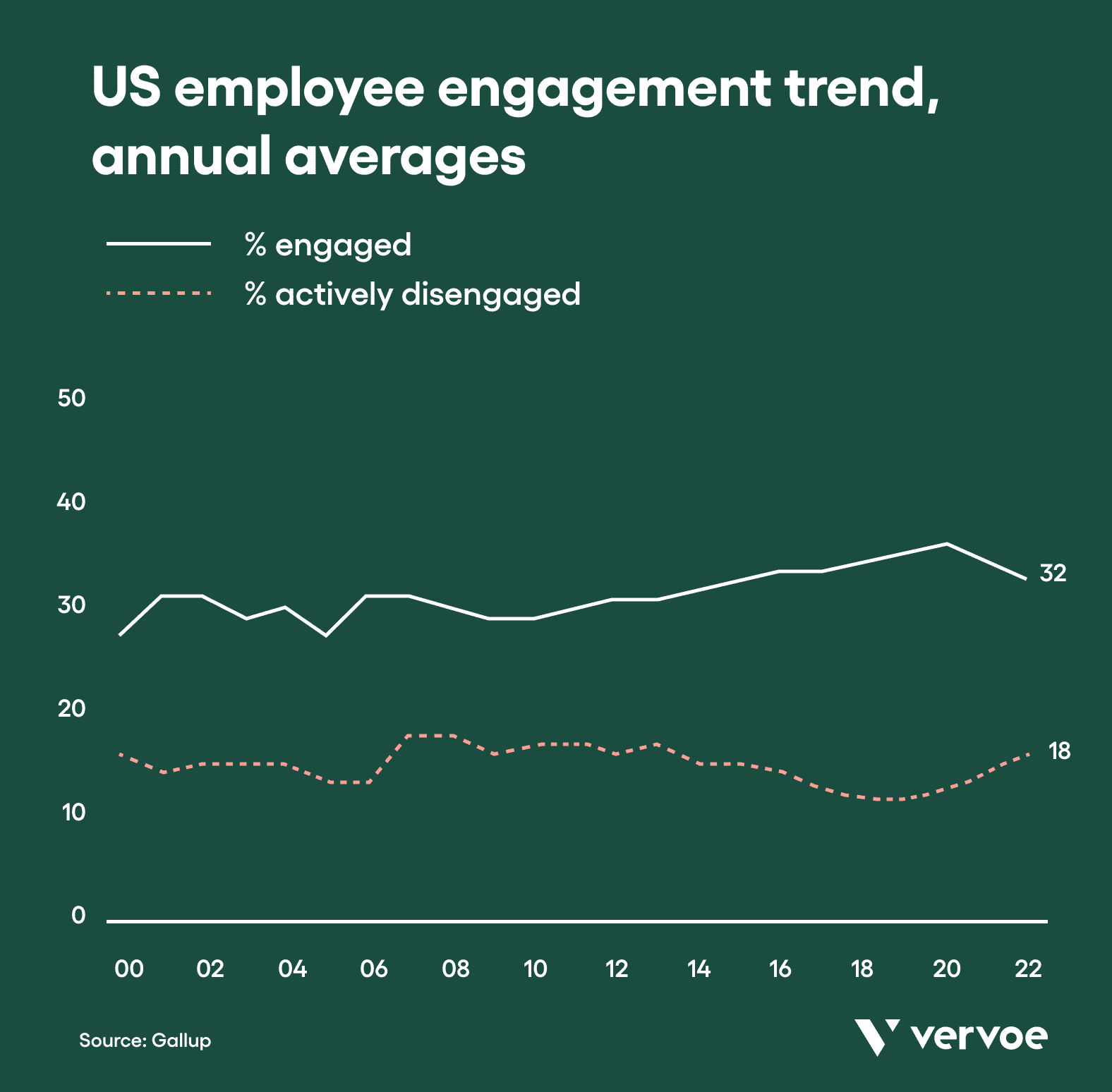
What has caused the quiet quitting phenomenon?
While findings are still being analyzed, most researchers agree that quiet quitting is the result of the following factors:
- In the aftermath of COVID-19, employees experienced heightened levels of stress, burnout, and disengagement due to staff shortages and increased expectations. According to a ResumeBuilder.com survey, 8 in 10 quiet quitters are burned out.
- The introduction of remote working allowed employees to get a taste of work-life balance, prioritizing employment while finding more time for other meaningful activities.
- Many employees believe employee disengagement and burnout result from poor management and support.
- Following the Great Resignation, where a record number of US employees quit or changed jobs, workers are seemingly better positioned to work on their terms. With many organizations feeling the full weight of the candidate shortage, employees feel more at ease requesting better pay and working conditions.
- We’re experiencing a generational shift in how workers perceive the importance of work. In a recent ResumeBuilder.com survey, roughly 25% of workers across all age groups admitted to doing the bare minimum at work — with 30% of respondents aged between 25-34, compared to 8% of employees aged over 54.
According to Human Leaders, a few additional root causes of quiet quitting may include a lack of purpose and connection at work, inadequate pay, micromanagement, feeling underutilized or unchallenged, not taking owed time off, inadequate communication and unclear expectations, a lack of trust and psychological safety, and a lack of career progression.
What can employers do to mitigate the risks of quiet quitting?
While the power appears to be in the hands of employees when it comes to quiet quitting, most findings suggest that organizations ultimately have the most significant role to play in either improving or exacerbating the issue. Here are four simple measures organizations can take to prioritize employee satisfaction and engagement.
1. Understand the reluctance to hustle
According to a ResumeBuilder.com survey, employers have an unavoidable duty to prioritize their employees’ well-being, ensuring they’re adequately compensated for their efforts. The survey found that employees are reluctant to go above and beyond for employers due to poor remuneration (46%), to prioritize their mental health (45.6%), to maintain a positive work-life balance (40.8%) and because the reward (career progression) doesn’t outweigh the effort (35.4%).
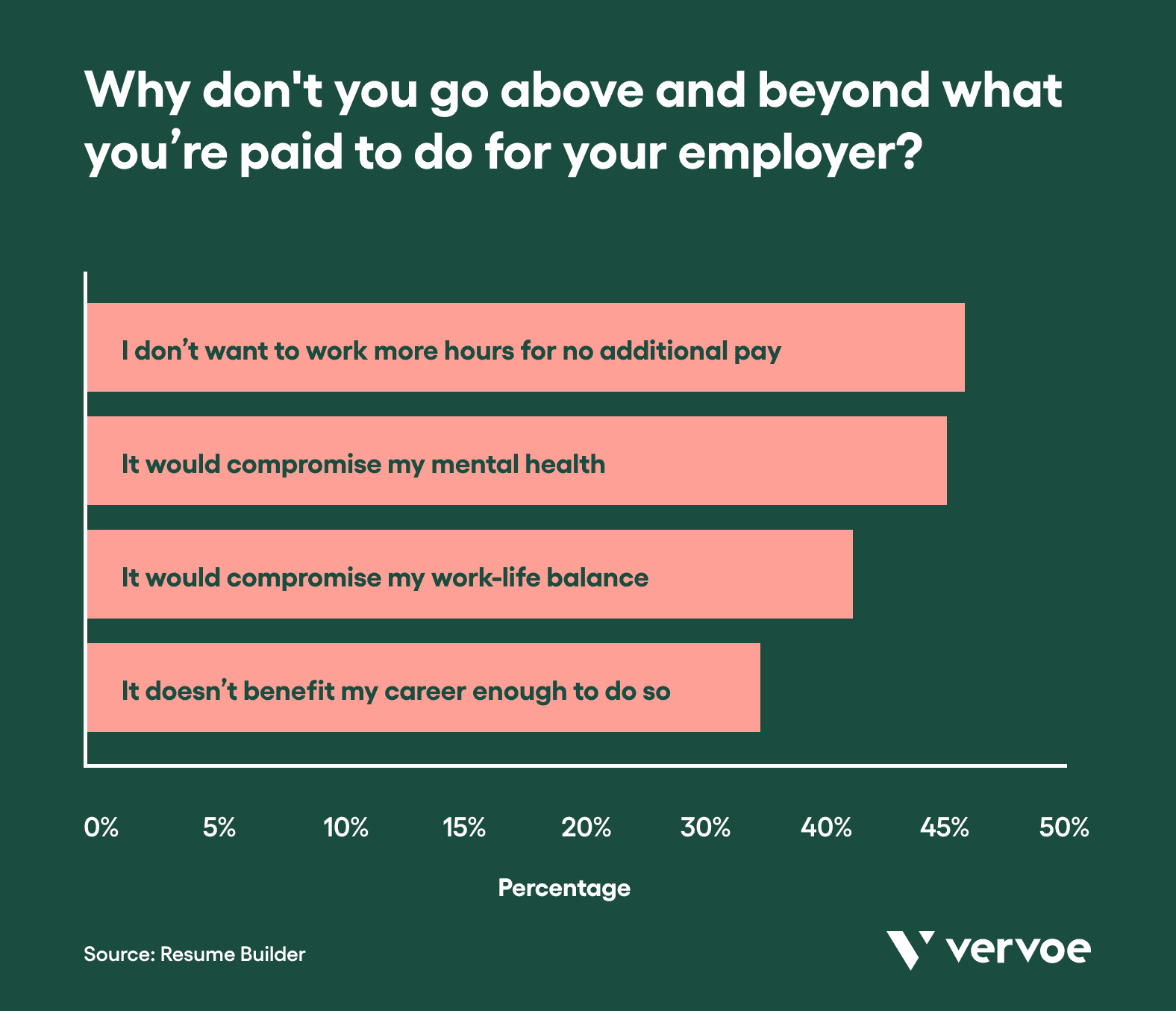
2. Incentivize employees in meaningful ways
The same survey found that a solution does exist, with many employees admitting they’d feel more incentivized to work harder for increased pay, more paid time off, improved healthcare, more promotional opportunities, greater recognition, and a better job title.
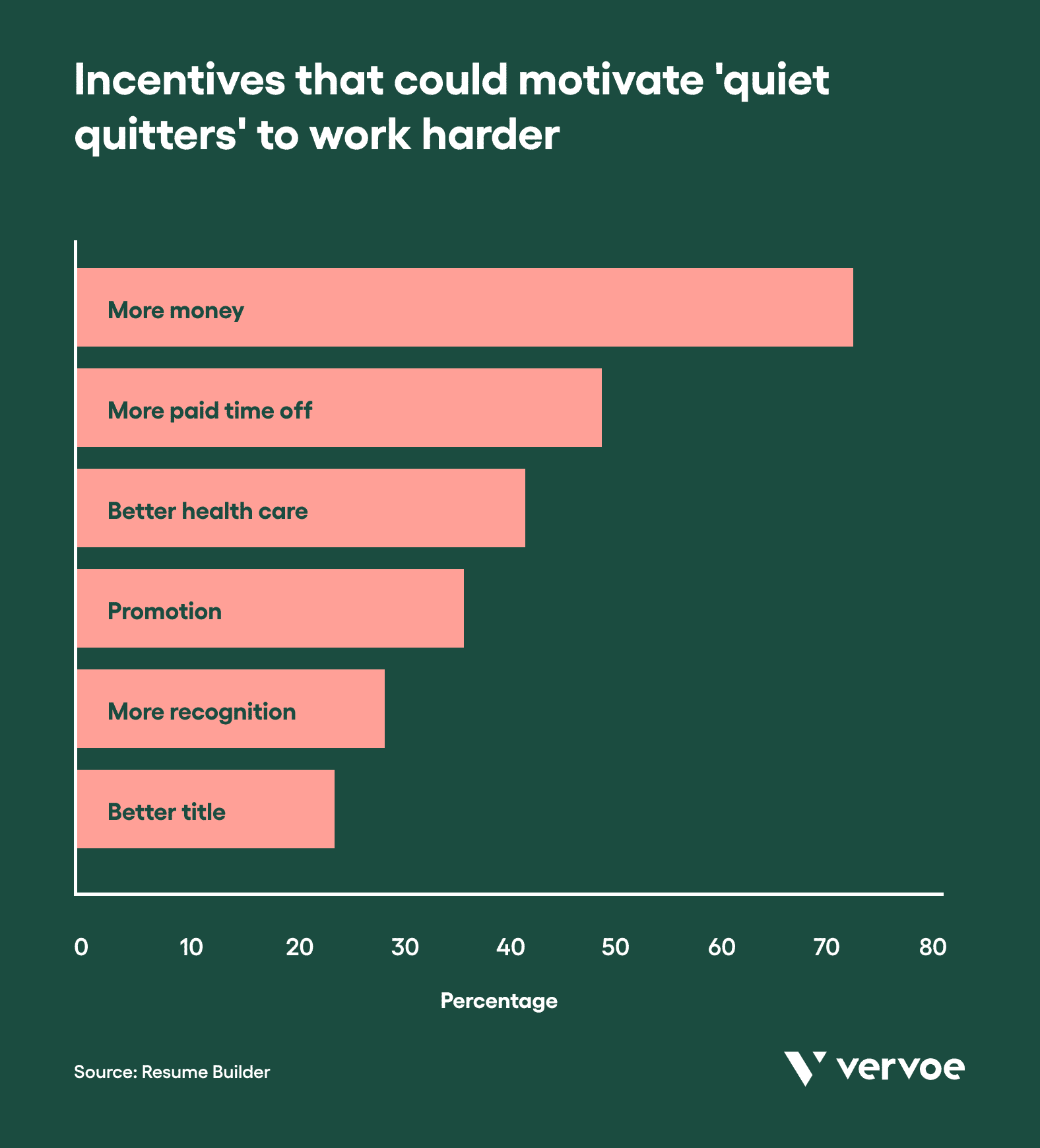
3. Focus on improving management and leadership teams
While reward and recognition appear to be contributing factors, they’re not the only areas of opportunity for organizations to improve upon. According to a Harvard Business Review workplace study, quiet quitting is more so a response to poor workplace culture — namely bad bosses.
Consider the following findings from HBR, which analyzes data gathered on almost 3,000 managers since 2020:
- Managers with the lowest ratings have three to four times as many ‘quiet quitters’ in their teams as managers with the highest ratings.
- The least effective managers experienced 14% of their direct reports quietly quitting (i.e., disengaged) and only 20% willing to put in the extra work.
- The most effective managers saw only 3% of their direct reports quietly quitting and 62% of employees willing to go above and beyond what’s expected of them.
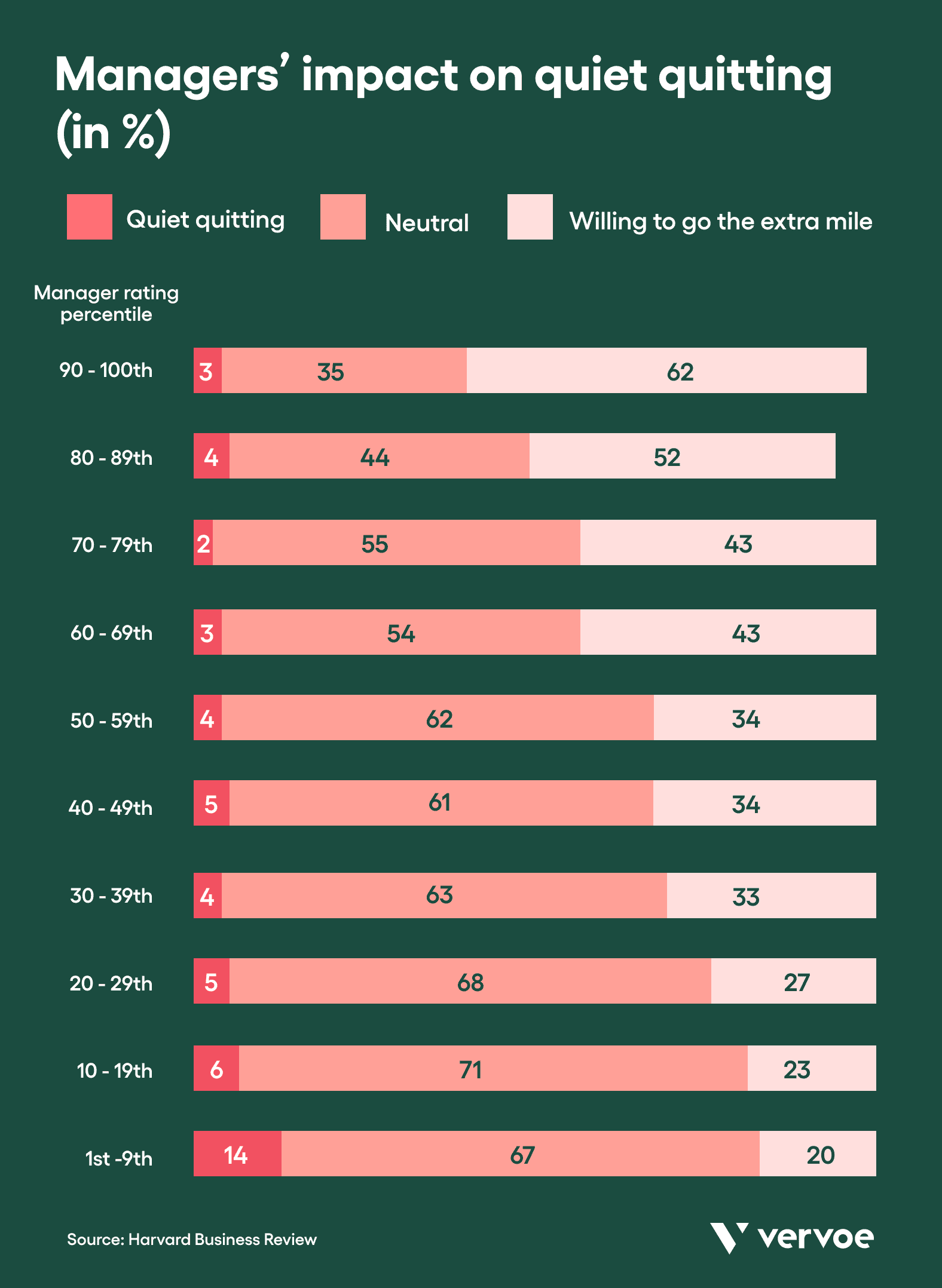
According to HBR’s findings, there are three primary connection points that managers can focus on to improve engagement and results:
- Trust — Do you speak honestly with your team and set clear expectations? Do you ensure your team feels valued? Do you show concern for your team members’ well-being?
- Consistency — Do you deliver upon your promises and set clear expectations for yourself?
- Expertise — Are you up to date on industry knowledge? Do you know how to perform your role well? Are you trusted and respected for your input?
4. Learn from top-performing organizations with high employee engagement
While many businesses — large and small — are succumbing to the impact of quiet quitters, there are plenty of outliers making a stand to take action quickly. According to Gallup’s Exceptional Workplace Award winners, who averaged a 70% employee engagement rate in 2021, here are the approaches that returned the greatest reward:
Use realistic job previews when hiring
The reality of what it’s like to do a job at a particular organization doesn’t always line up with what seems to be on offer when applying. At Vervoe, we know strong engagement and high retention starts with offering a realistic job preview when hiring. After implementing
Vervoe to validate candidate skills at his old company, Omnicom Media Group, Talent Acquisition Director for Dentsu, Dan Stockdale watched the company’s attrition numbers shrink by 75%. Now, he’s seeing similar results at Dentsu.
By simulating day-to-day tasks candidates will be completing on the job, and providing them with as close to a day-in-the-life experience as possible in your job preview, they’ll know what they’re in for, can self-select out of the process if the job’s not for them, and you’ll be left with only the most engaged candidates.
Align your values with business decisions
Organizations that incorporate their organizational culture and values into their daily decision-making garner more employee trust. For example, businesses that spent above their original budget to support employee well-being and flexibility during the pandemic saw greater employee engagement.
Incorporate permanent flexible working arrangements
Organizations that allow their employees to work flexibly in their preferred way improve employee performance and engagement. While the future of working conditions is unknown, organizations should welcome flexibility rather than look for opportunities to return to a post-pandemic working environment.
Prioritize employee wellbeing and recognition
Organizations witnessing high employee engagement generally look at their employers as a whole. This means understanding the balance between work and life and acknowledging that the two cannot be easily separated. Simply consider how work life, social commitments, financial situations, and physical well-being affect an employee’s ability to perform in the workplace and provide support and resources to assist these areas where needed.
Invest in management team training
From Gallup’s findings above, poor management leads to employee disengagement. As such, organizations should train and upskill their managers to help each individual perform to the best of their ability, collaborate effectively within the team, and bring value to their customers. This includes setting clear expectations, ensuring sufficient resources are on hand, and giving their employees the best chance to succeed in their roles.
Final thoughts
While the potential impact of employees quietly quitting is frightening, it’s offering organizations the opportunity to look inwards at their management style and foundation to get serious about improving their workplace culture.
What exactly does this mean? Organizations should approach the quiet quitting phenomenon with excitement rather than fear — acknowledging the value of getting a clear insight into employees’ concerns and the reasons inhibiting their workplace engagement.
While the cause of disengagement can be easily attributed to laziness and unmotivated workers unwilling to put in the hard yards for career development, the findings paint a contrasting view. Instead, researchers are urging organizations to understand why their employees feel disconnected from their jobs and are encouraging them to incorporate effective measures to incentivize employees (i.e., salary reviews, recognition, flexible working arrangements, etc.).
Additionally, organizations should invest in team management and leadership training to ensure the impact trickles down from the top down. Along with realistic job previews to give candidates a true sense of what it will be like to actually do the job — weeding out less engaged ones.
To find out more about how Vervoe can reduce your chances of hiring quiet quitters, see the product in action, start a free trial, or book a demo.




















